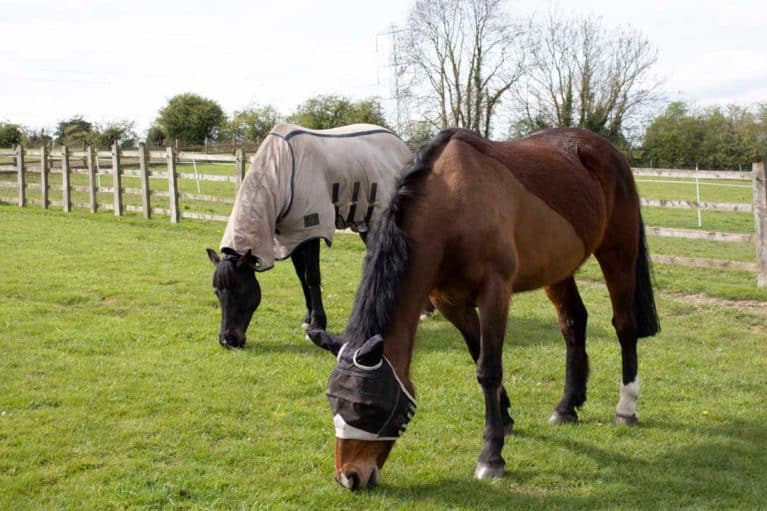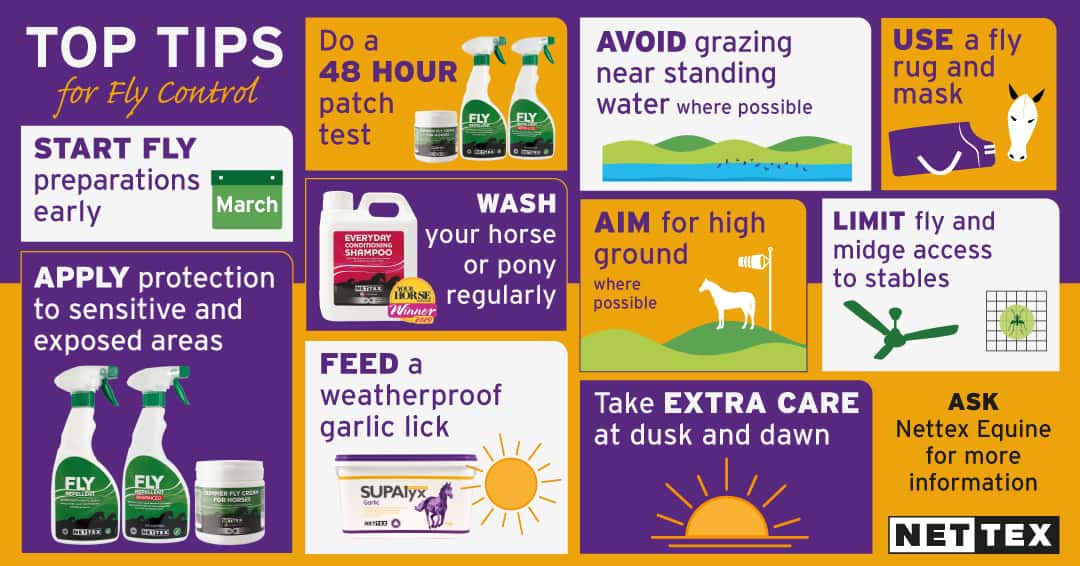Get ahead of the flies this season with Nettex Equine’s top tips

When your horse should be enjoying the warmer months basking in the sunshine and all of the lush grass growth it brings, it can quickly turn from delightful to depressing if a swarm of unwanted flying insects takes hold. Not just impinging on your horse’s turnout time, flies can impinge on our hours in the saddle, too. And, while you’re likely to have your own tried and tested methods for banishing these pesky pests from your yard, there’s no harm in adding more weapons into your arsenal – check out these handy snippets of advice…
Apply protection to sensitive and exposed areas
Your horse’s face and ears are highly reactive to midge bites and taking care of these areas requires careful thought and often multiple modes of protection. A physical barrier, such as a fly mask that covers the ears and part of the face, is effective and helps protect the eyes, which flies are drawn to. Topical solutions, such as Nettex Equine Summer Freedom can be applied to the external areas of the ears, and face, including the muzzle as a repellent. Don’t apply to sunburnt areas on the muzzle.
Don’t forget the sensitive skin around the sheath and belly, and behind elbows, too. Often harder to shield with rugs, regularly applying a repellent such as Nettex Equine Fly Repellent Advanced or Nettex Equine Fly Repellent Standard, helps deter flies from landing on delicate skin.
Do a 48-hour patch test
Ingredients used in fly repellents are well tolerated by the majority of equines, but even so, for any new product you use, a patch test is advised. This reduces the risk of your horse having a widespread adverse reaction to any product. To perform a patch test, apply the product to a small area of skin and leave for 48 hours, then check for any form of reaction before continuing use.
Wash your horse regularly
Sweat, urine, faeces – flies can’t help but be attracted to these aromas. Washing your horse regularly will remove such attractants can help remove him from being a prime target for flies. Make sure to wash your horse after exercise, or on hot days, and wash off any stable stains thoroughly. Nettex Equine Everyday Conditioning Shampoo is ideal for keeping your horse clean and smelling fresh.
Feed a weatherproof garlic lick
Keeping more than just vampires away, garlic contains a natural sulphur compound that helps to deter black flies and most small flying insects. Adding a lick such as Nettex Equine SUPAlyx Garlic can help to deter flies from landing on your horse.
Avoid grazing near rivers and streams
If possible, try to keep your horse’s grazing away from rivers, streams and damp, wet areas. Such places have higher populations of flies and midges, as they tend to gather over water sources. Both horseflies and midges lay their eggs in water and damp vegetation, making it an ideal breeding ground for these annoying critters. Removing your horse from these areas can dramatically help to reduce their exposure.
Aim for high ground, where possible
Flies like damp areas with no natural airflow, so providing the opposite as an environment for your horse helps deter unwelcome pests. High ground is generally more exposed than lower lying areas, which means it tends to have greater airflow and movement, and it’s less likely to be near standing water – an altogether less appealing environment for flies, making it a perfect place for your horse and pony to avoid them. Fly fact: midges have tiny wings, so they struggle to fly in winds above 7mph.
Take extra care at dusk and dawn
While midges can bite at any time, swarms of adult midges are particularly active at dawn and dusk. Extra precautions around these times should be carried out, such as ensuring fly rugs/masks are worn and correctly secured, removing horses from areas close to water, and applying repellents.
Use a fly rug and mask
For horses who are particularly sensitive to fly and midge bites, fly rugs and masks can be extremely helpful in managing their comfort. Take care if applying creams or sprays under fly rugs and masks. In very hot weather, horses often sweat under rugs and masks, which may lead to a reaction. Apply fly sprays to the outer of the rug to help deter flies and midges from landing on them. When fitted correctly, rugs and masks provide an effective physical barrier against flies. To deter flies further, choose a striped or spotted rug, or one that is bright white in colour. Flies are attracted to polarised light, but such rugs reflect this light, making it less attractive for flies.
Another important thing to remember is to keep rugs and masks clean and free from dirt. If this is difficult to manage, where possible, have a spare fly rug and mask to give yourself more time between washes and to ensure your horse is never without a rug on laundry days.
Remember that midges happily fly into stables (unlike horseflies who don’t like shade), so fly rugs should still be worn when your horse is in away from pasture, if necessary, as well as in the field.
Limit fly and midge access to stables
Midges and some flies will follow your horse into his stable, but there are steps you can take to limit their access. Firstly, keep stables clean and dry, removing urine and faeces regularly, to make the area less appealing to flies.
Generally, flies prefer areas with no natural airflow so providing good airflow through barns and stables, or even a fan if your horse will tolerate it, can help to reduce flying visitors. If your horse gets plenty of time out in the field socialising, then fly nets can also be used on stable doors when he’s indoors to limit fly and midge access.
You can also use nature’s own defence system and use natural predators to control the fly burden. Although many people discourage swallows and house martins from nesting in stables, they consume fly eggs and larvae, so are quite handy to have around.









